
Here it is!
Hive.blog is the front-end web interface that allows you to interact with the Hive blockchain.
In this guide, we will start from the main thing, how to create an account, and then we will deal with some other fundamental aspects: the keys (password), your Wallet, the differences with the other social networks and more.
Registration
There are several ways to register on the platform.
In the site https://signup.hive.io/ you will find all the possible ways. Here we will report some of them below:
- HiveOnboard: Within HiveOnboard, you can create an account in a few simple steps and completely free of charge. However, verification by telephone is required;
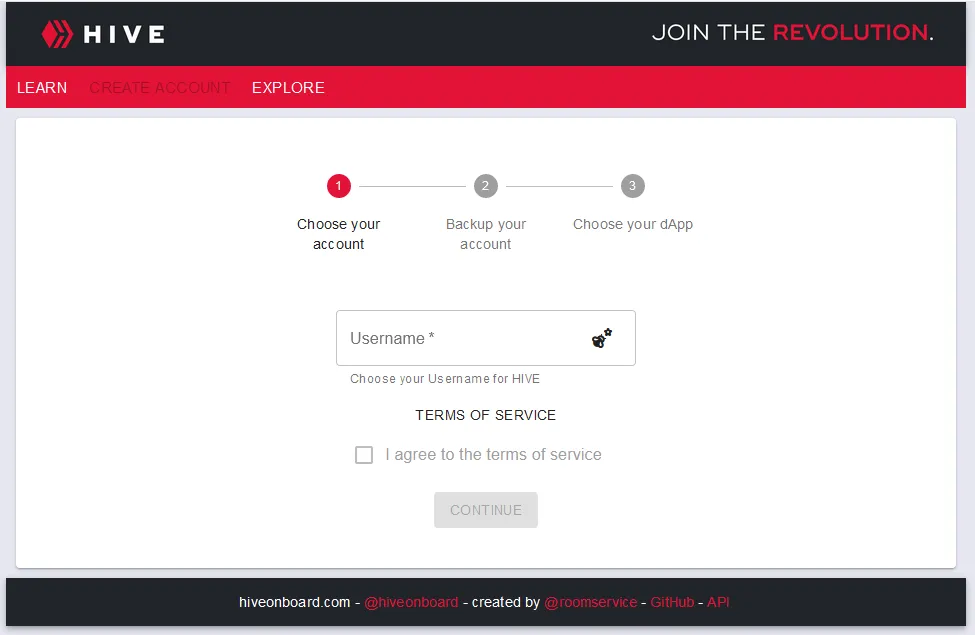
- Esteem: Also through the Esteem app you can create an account with a few simple steps and for free, but you will be asked an email;

- Paid: BlockTrades and 3speak
These services allow you to request a completely anonymous account and without the need for verification.
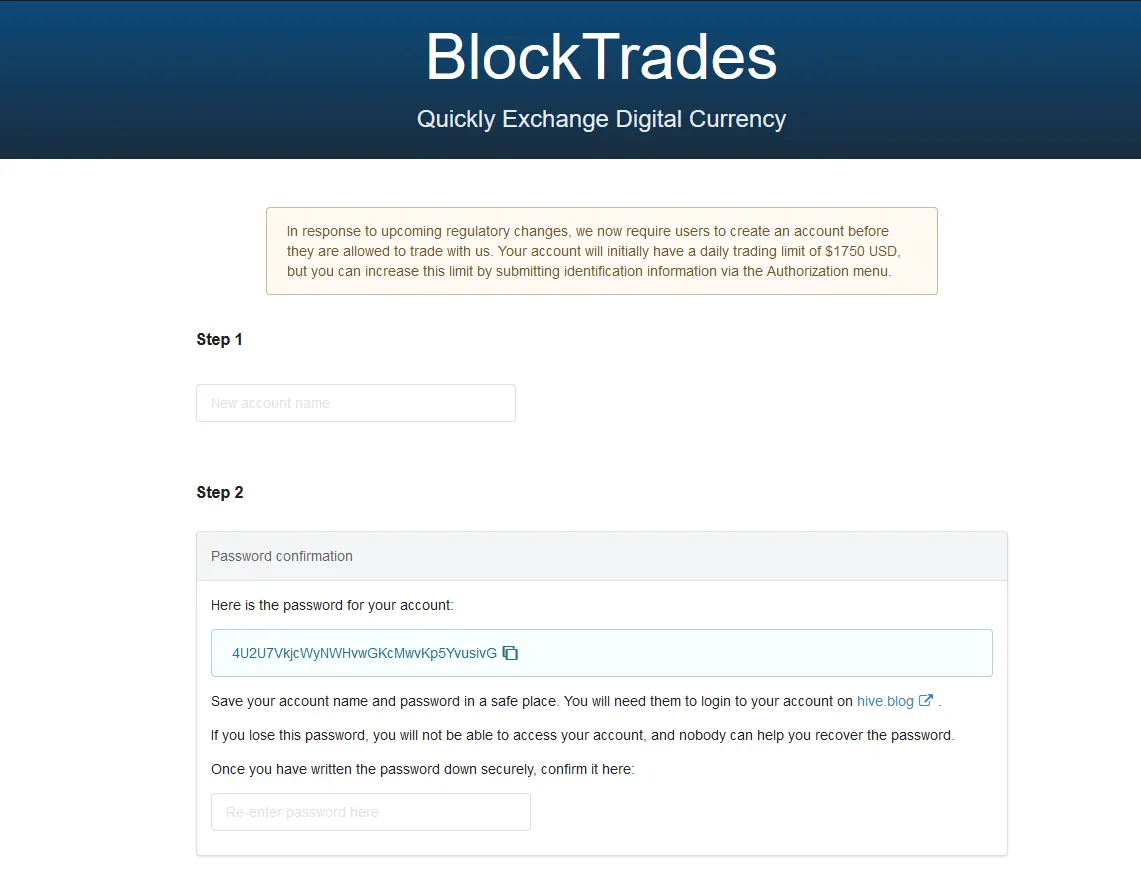
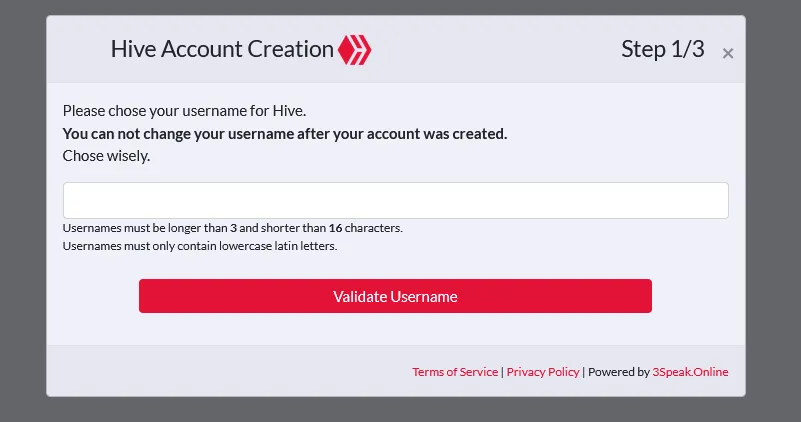
The differences between the various methods of registration are almost nil.
In fact, each account is actually paid within this blockchain. As we will explain later, to carry out actions within the blockchain it is necessary to hold a minimum quantity of Hive in your Wallet, this will allow the account to carry out all transactions.
Password
One thing you will never have to forget are your passwords or keys, which we advise you to keep carefully and/or print.
At the first access, you will be presented with a .pdf file containing all the passwords, which are 5:
- Private Posting Key: It is used to perform social actions such as posting, commenting and voting;
- Private Memo Key: It is used to decrypt private memos in transactions;
- Private Active Key: It is used for all actions related to the Wallet, such as transferring Tokens and performing Power-Up and Power-Down;
- Private Owner Key: This key is used to reset all the others and is very useful for recovering compromised accounts;
- Master Password: It was used to generate the document with all the keys.
Hive.blog interface
Once you finally manage to log in, here's what the Home looks like:

- Thanks to the left menu, where we find " All posts ", " My friends " and " My communities ", we can limit which posts we want to view;
- At the center of the page, we find the posts of other users. We can choose how to categorize them thanks to the drop-down menu, which allows us to view them in chronological order "New", or based on " Trending ", or " Payout ", etc;
- At the top right, we find two basic buttons. The first is the one that allows you to write posts, the second, the one with our profile picture, is a drop-down menu that allows you to directly access to your profile, notifications, the Wallet and much more.
Writing posts on Hive is simple but, at the beginning, some things may be unclear. We plan to make a specific guide about it but, for now, the fundamental aspects to know are:
- Hive.blog offers Markdown as a writing language;
- It is possible to use the tags, of which the first 5 are the most important, which allow you to categorize the different posts to facilitate the search by theme;
- You can choose whether to publish the post in a specific Community;
- Links, photos and videos can be added, as long as there is always respect for copyright.
Why Hive is different from other social networks
The fundamental feature that differentiates Hive from other social networks is the fact that it is based on a blockchain.
This has several consequences. First of all, the immutability of the actions, as we will see better explained later. Furthermore, the possibility of receiving rewards for your blogging activity is certainly a very innovative aspect.
The rewards that the user can obtain derive not only from the activity of creating new content on their blog, but also from commenting on and voting on posts created by others. In fact, one of the fundamental things of Hive is curation, or the gesture of using the Up-Vote button to enhance posts written by other users. There is also a Down-Vote, which is mainly used to report abuse.
The quality and originality of the contents are very important on Hive. In this regard, Communities were recently born, which have as main purposes:
- Reorganize posts based on interests and macro-topics;
- Be a meeting place for users;
- Enhance quality content by offering support.
Communities are many and there is no numerical limit for registration. Here you can find ours: Discovery-it!
Hive Power, Resource Credit and more
Within Hive, the ability to perform actions will directly depend on the amount of Hive Power (HP) present in the Wallet.
For example, a newly created account with x HP will only be able to:
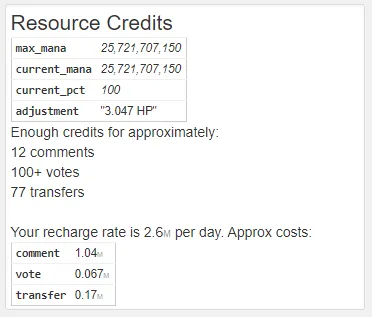
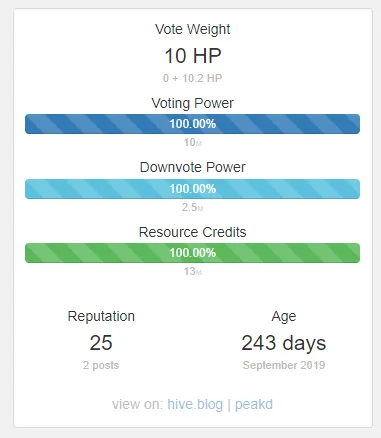
While, as we see from this screen, an account with 1000 HP inside it, will be able to perform many more actions.

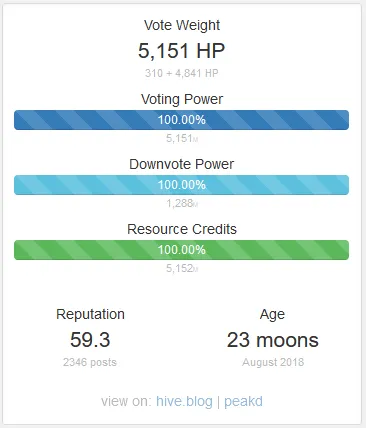
You can control your Hive Power via Peakd.com (through the "Tools" drop-down menu) or Hiveblocks and, on first access, your personal page will look like this:

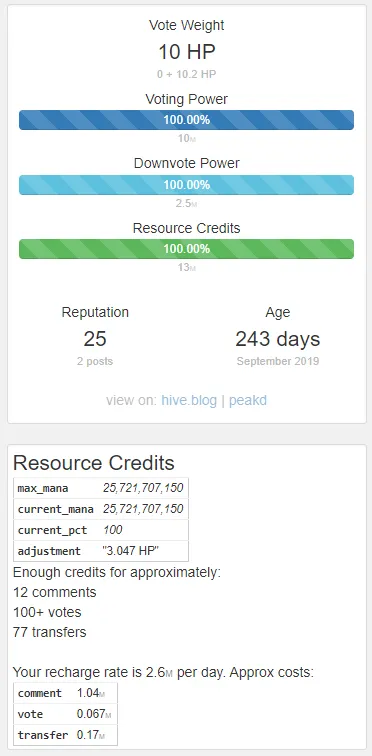
Through the above-mentioned platforms, other very important parameters can also be kept under control:
Voting Mana: It is a bar that informs us about the residual content of our vote. In fact, starting with 100%, every time we go to vote for content within the platform, our voting power will be consumed by 2% and, moreover, the votes given with Mana lower than 100% will have less value. However, this parameter is recovered by about 20% every 24 hours. Another important aspect is that, as regards new users, it is possible to vote only with 100% of the voting strenght, while, from 500 HP onwards, it will be possible to adjust the weight of the percentage of one's vote;
Resource Credit: Every single action that is carried out in the blockchain involves, similarly to what happens with the Voting Mana, progressive depletion of the Resource Credit. For example, to publish on the blog, make Tokens transactions, actions such as follow and un-follow and comment, this parameter decreases significantly and it is important not to waste it, especially when you are a novice, as you risk being unable to do any action on the platform.
Wallet
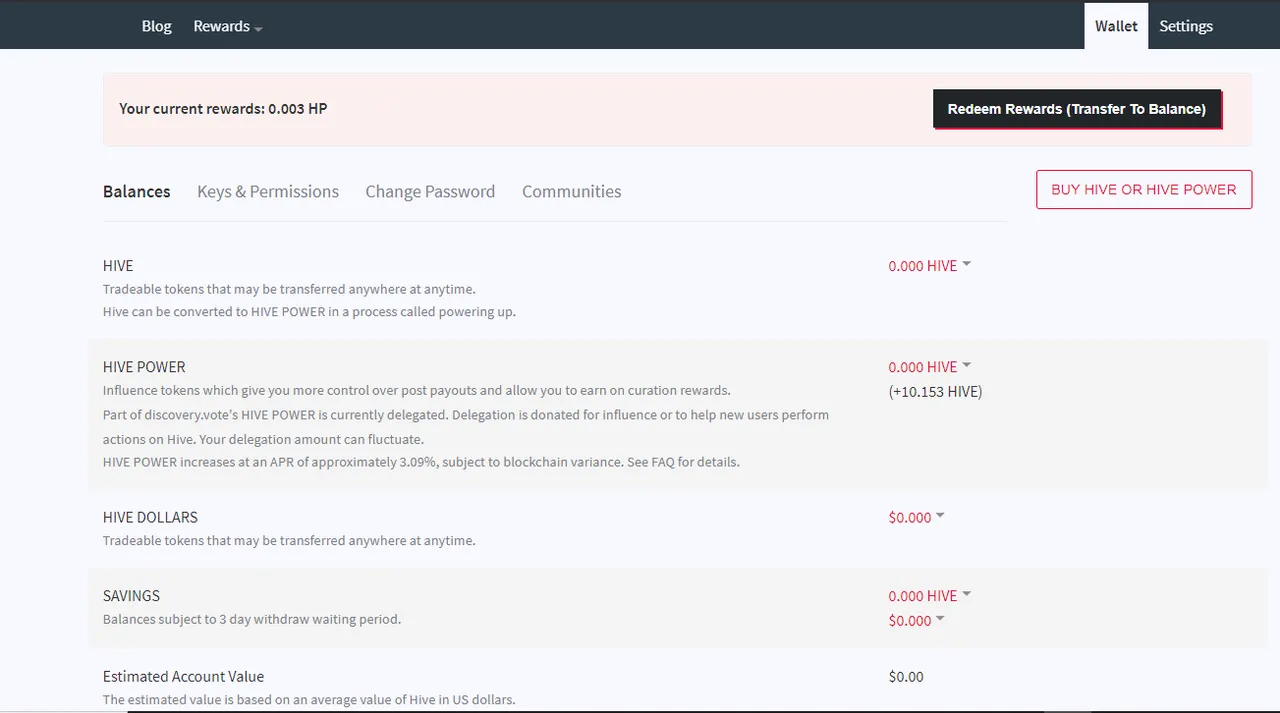
The Wallet is located in a different place from the Blog. When you open your Wallet, a scenary presents itself that in the early days may seem very confusing. In fact, we find some terms whose meaning needs to be explained:
- HIVE: It is the main liquid currency of the platform. This can go to different fates: transferred to Hive Power with the process called Power-Up, negotiated for Hive Dollars or transferred to other accounts;
- HIVE POWER: As previously mentioned, it is the measure of the influence of a user within the platform. It does not have a direct liquidity meaning, but through the process called Power-Down, it can be converted back to Hive;
- HIVE DOLLARS: These are Tokens with a stable value compared to 1 USD. This is the internal stable coin of the Hive system and guarantees the balance of the platform;
- SAVINGS: The safest place to keep Hive in case of account compromise;
- Estimated Account Value: It is an estimated average of the value of the account;
- HISTORY: The history of the latest transactions.
You have surely noticed that in our wonderful platform there are no long alphanumeric addresses to indicate your Wallet, but, rather, your nickname will act as your address. What easier way to send and receive Hive?
A look at the Blockchain
Given that it is the foundation of Hive, it is important to know some general information on the blockchain. It is the backbone of the entire cryptocurrency system and mainly performs two tasks:
- Allows users to perform transactions;
- Guarantees security and anonymity.
In practice, it is an ever-growing list of blocks, which are linked together and protected by encryption. This "collector" is shared by all users of the network and this is how transparency and trust in the system are guaranteed.
Each time a block is completed, a new one is generated. Once recorded, the data in a particular block cannot be edited or deleted. So, the transactions, once stored in the Blockchain, are permanent!
It goes without saying that:
- It is necessary to share only original content, including photos and videos, paying attention to copyright. Plagiarism is taken very seriously;
- The positive aspect is that nobody can manipulate, even after some time, the contents that have been proposed (immutability).
We plan to make more guides later! Follow us for update.
Thanks for your attention
Special thanks to:
@HiveOnboard
@Roomservice
@esteemapp
@BlockTrades
@threespeak
@Peakd
Ciao! Sei appena arrivato su Hive e non sai come funziona? Un tuo amico ti ha detto di iscriverti e vuoi avere una facile guida a portata di mano?

Eccola finalmente!
Hive.blog è l’interfaccia front-end web che permette di interagire con la blockchain Hive.
In questa guida, inizieremo dalla cosa principale, ovvero come creare un account, per poi affrontare alcuni aspetti fondamentali: le chiavi (password), il tuo Wallet, le differenze con gli altri social networks e altro ancora.
Registrazione
Esistono diversi modi per effettuare la nostra registrazione sulla piattaforma.
All'interno del sito https://signup.hive.io/ troverete tutte le scelte possibili, ne riporteremo alcune qui di seguito:
- HiveOnboard: All'interno di HiveOnboard, è possibile creare un account in pochi semplici passaggi e in maniera del tutto gratuita. Necessita, però, di una verifica tramite telefono;

- Esteem: Anche tramite l'app Esteem è possibile creare un account con pochi semplici passaggi e gratuitamente, ma vi verrà richiesta un’e-mail per effettuare l'accesso;

- A pagamento: BlockTrades e 3speak
Questi servizi permettono di richiedere un account completamente anonimo e senza la necessità di verifica.


Le differenze tra le varie modalità di registrazione sono pressoché nulle.
Infatti, ogni account è in realtà a pagamento all'interno di questa blockchain. Come spiegheremo più avanti, per effettuare azioni all'interno della blockchain è necessario detenere un minimo quantitativo di Hive nel proprio Wallet, questo permetterà all'account di effettuare tutte le transazioni.
Password
Una cosa che non dovrai mai scordare sono le tue password o chiavi, che ti consigliamo di conservare accuratamente e/o stampare.
Al primo accesso, ti sarà presentato un file .pdf contenente tutte le password, le quali sono 5:
Private Posting Key: Serve per compiere azioni social come postare, commentare e votare;
Private Memo Key: È utilizzata per decriptare memo privati nelle transazioni;
Private Active Key: Serve per tutte le azioni correlate al Wallet, come trasferire Tokens ed effettuare Power-Up e Power-Down;
Private Owner Key: Questa chiave serve per resettare tutte le altre ed è molto utile per recuperare account compromessi;
Master Password: Utilizzata per generare il documento con tutte le chiavi.
Interfaccia Hive.blog
Una volta che, finalmente, si riesce a effettuare il login, ecco come si presenta la Home:

Grazie al menu di sinistra, dove troviamo “All posts”, “My friends” e “My communities”, possiamo limitare quali post vogliamo visualizzare;
Al centro della pagina, troviamo i post degli altri utenti. Possiamo scegliere come categorizzarli grazie al menu a tendina, che ci permette di visualizzarli in ordine cronologico “New”, o in base al “Trending”, o al “Payout”, etc;
In alto a destra, troviamo due pulsanti fondamentali. Il primo è quello che consente di scrivere i post, il secondo, quello con la nostra immagine del profilo, è un menu a tendina che consente di accedere direttamente al proprio profilo, alle notifiche, al Wallet e molto altro.
Scrivere i post su Hive è semplice ma, all’inizio, alcune cose possono essere poco chiare. Abbiamo in progetto di fare una guida specifica a riguardo ma, per ora, gli aspetti fondamentali da sapere sono:
- Hive.blog propone il Markdown come linguaggio di scrittura;
- È possibile utilizzare i tags, di cui i primi 5 sono i più importanti, i quali consentono di categorizzare i diversi post per facilitare la ricerca in base alle tematiche;
- Si può scegliere se pubblicare il post in una Community specifica;
- Si possono aggiungere link, foto e video, purché ci sia sempre rispetto del copyright.
Perché Hive è diverso dagli altri social networks
La caratteristica fondamentale che differenzia Hive dagli altri social networks è il fatto di essere basato su una blockchain.
Questo comporta diverse conseguenze. Innanzitutto, l’immutabilità delle azioni, come vedremo spiegato meglio in seguito. Inoltre, la possibilità di ricevere ricompense per la propria attività di blogging è senz’altro un aspetto molto innovativo.
Le ricompense che l’utente può ottenere non derivano solo dall’attività di creare nuovi contenuti sul proprio blog, ma anche dal commentare e dal votare post creati da altri. Infatti, una delle cose fondamentali di Hive è la curation, ovvero il gesto di utilizzare il tasto Up-Vote per valorizzare post scritti da altri utenti. Esiste anche il Down-Vote, che viene utilizzato principalmente per segnalare gli abusi.
La qualità e l’originalità dei contenuti sono molto importanti su Hive. A questo proposito, di recente sono nate le Communities, le quali hanno come scopi principali:
- Riorganizzare i post in base agli interessi e ai macro-argomenti;
- Essere un luogo di ritrovo per gli utenti;
- Valorizzare i contenuti di qualità offrendo supporto.
Le Communities sono molte e non esiste un limite numerico per l’iscrizione. Qui potete trovare la nostra: Discovery-it!
Hive Power, Resource Credit e altro
All'interno di Hive, la possibilità di compiere azioni dipenderà direttamente dall'ammontare di Hive Power (HP) presente nel Wallet.
Ad esempio, un account appena creato con x HP potrà compiere soltanto:


Mentre, come vediamo da questo screen, un account con al suo interno 5000+ HP, potrà compiere molte più azioni:


È possibile controllare il proprio Hive Power tramite Peakd.com (attraverso il menu a tendina “Tools”) oppure Hiveblocks.com/@youraccount e la propria pagina personale si presenterà in questo modo:


Attraverso le piattaforme sopra menzionate, si possono tenere sotto controllo anche altri parametri molto importanti:
Voting Mana: Si tratta di una barra che ci informa sul contenuto residuo del nostro voto. Infatti, iniziando con il 100%, ogni qualvolta andremo a votare un contenuto all'interno della piattaforma, il nostro potere di voto si consumerà del 2% e, inoltre, i voti dati con Mana inferiore al 100% avranno meno valore. Questo parametro, però, viene recuperato di circa il 20% ogni 24 ore. Un altro aspetto importante è che, per quanto riguarda gli utenti nuovi, è possibile votare solamente con il 100% della forza di voto, mentre, dai 500 HP in poi, sarà possibile aggiustare il peso della percentuale del proprio voto;
Resource Credit: Ogni singola azione che viene compiuta nella Blockchain comporta, analogamente a quello che accade con il Voting Mana, esaurimento progressivo del Resource Credit. Ad esempio, per pubblicare sul blog, fare transazioni di token, azioni come follow e un-follow e commentare, questo parametro diminuisce sensibilmente ed è importante non sprecarlo, soprattutto quando si è novizi, in quanto si rischia di rimanere impossibilitati dal fare qualunque azione sulla piattaforma.
Wallet

Il Wallet è dislocato dal Blog. All’apertura del proprio Wallet, si presenta uno scenario che i primi tempi può sembrare molto confusionario. Infatti, troviamo alcuni termini di cui è necessario spiegare il significato:
HIVE: È la valuta liquida principale della piattaforma. Questa può andare incontro a diversi destini: trasferita a Hive Power con il processo chiamato Power-Up, negoziata per Hive Dollars o trasferita ad altri account;
HIVE POWER: Come già accennato in precedenza, è la misura dell’influenza di un utente all’interno della piattaforma. Non ha un significato di liquidità diretto, ma attraverso il processo chiamato Power-Down, può essere riconvertita a Hive;
HIVE DOLLARS: Sono i token con valore stabile paragonato a 1 USD. Si tratta della stable coin interna del sistema Hive e garantisce l’equilibrio della piattaforma;
SAVINGS: Il posto più sicuro dove tenere Hive in caso di compromissione dell’account;
Estimated Account Value: È una media stimata del valore dell’account;
HISTORY: La cronologia delle ultime transazioni.
Avrete sicuramente notato che nella nostra stupenda piattaforma non esistono lunghi indirizzi alfanumerici per indicare il proprio Wallet, ma, bensì, sarà proprio il vostro nickname a fungere da indirizzo. Quale maniera più semplice per inviare e ricevere Hive?
Uno sguardo alla Blockchain
Essendo il fondamento di Hive, è importante conoscere qualche generalità sulla blockchain. Essa è la colonna vertebrale dell'intero sistema delle criptovalute e svolge prevalentemente due compiti:
- Permette agli utenti di eseguire transazioni;
- Garantisce sicurezza e anonimato.
In pratica, si tratta di un elenco in continua crescita di blocchi, i quali sono collegati tra loro e protetti da crittografia. Questo “raccoglitore” è condiviso da tutti gli utenti della rete ed è in questo modo che vengono garantite la trasparenza e la fiducia nel sistema.
Ogni volta che un blocco viene completato, ne viene generato uno nuovo. Una volta registrati, i dati in un determinato blocco non possono essere modificati o cancellati. Quindi le transazioni, una volta memorizzate nella Blockchain, sono permanenti!
Va da sé che:
È necessario condividere solo contenuti originali, compresi foto e video, facendo attenzione al copyright e ai diritti d’autore. Il plagio è preso in considerazione molto severamente;
L’aspetto positivo è che nessuno può manipolare, anche a distanza di tempo, i contenuti che sono stati proposti (immutabilità).
Abbiamo in progetto di realizzare altre guide in seguito! Seguici per aggiornamenti.
Grazie per l'attenzione!
Un ringraziamento speciale a:
@HiveOnboard
@Roomservice
@esteemapp
@BlockTrades
@threespeak
@Peakd
